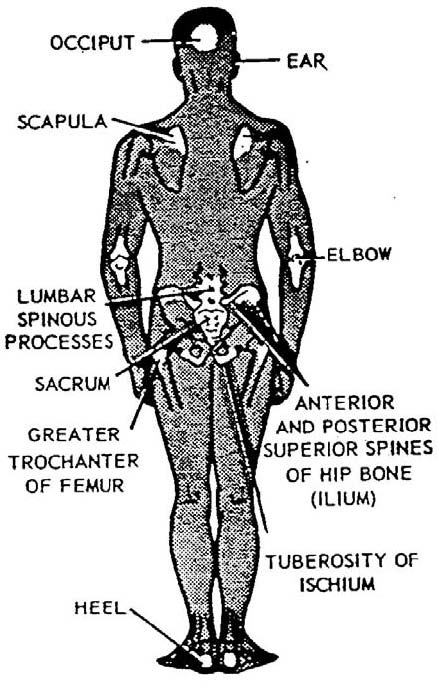 This is the Archived Desktop Edition.
This is the Archived Desktop Edition.
You should be transferred to the Newest Edition for Desktop and Mobile within 2 seconds.
Basic Patient Care Procedures
2-10
2-10. PREVENTION OF PRESSURE SORES
Timely change and movement of a patient's position as well as the knowledgeable uses of support devices go a long way toward the prevention of pressure or bedsores. Nevertheless, since pressure sores can develop within a few hours of neglect, constant vigilance and good nursing care can prevent them.
a. Areas of Susceptibility. Pressure sores are more likely to develop over the more bony prominence of the body (figure 2-27). In addition, sores can also develop on such areas as toes, knees, shoulders, chin, and forehead when circulation to the skin of these areas is restricted by the pressure of body weight and the patient is unable to move.
Figure 2-27. Areas susceptible to bedsores.
b. Stages of Development. Pressure sores develop in three recognized stages.
(1) The first stage reveals redness of the skin in the area.
(2) In the second stage, a bluish or mottled (blotches of different shades) discoloration of the skin occurs.
(3) In the third stage, there is a break in the skin that can develop rapidly into a decubitus ulceration (a destruction of underlying tissue).
c. Preventive Nursing Measures. Pressure sores can complicate recovery of the patient for weeks and even months. Therefore, nursing personnel must be alert and perform the following preventive measures.
(1) Change the patient's position at least every 2 hours, or more frequently if necessary. Remember that there are four body surfaces on which to turn the patient to relieve pressure on any one area.
(2) Inspect all skin areas of all bed patients daily during the bath procedure and at evening care. Massage skin areas over bony prominence to stimulate circulation. Report any
suspicious (reddened) area immediately to the nurse in charge, and relieve pressure by changing position. Report any complaint of numbness or tingling under a cast or splint.
(3) Keep the patient's skin clean and dry. Wash areas soiled by body excretions immediately with soap and water, rinse well, and dry thoroughly.
(4) Keep bed linen clean, dry, free of wrinkles, and free of crumbs and any other foreign matter.
(5) Use pillows and all positioning and comfort devices properly. Rubber rings, cotton doughnuts, and similar articles often cause new circumscribed pressure areas; hence, they should not be used.
d. Treatment of Pressure Sores. The best treatment is prevention by proper nursing care. The medical officer's orders must be followed for application of any medication. Aseptic technique must be used on any broken skin areas.

